Flood Preparedness
Floods are the most common natural disaster in the US. In the last five years, all 50 states have experienced flooding, so it’s important to be prepared in case a flood does hit.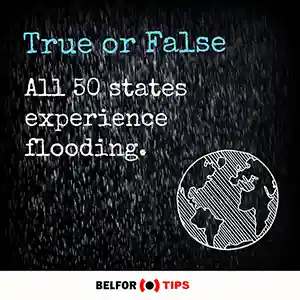
What To Do Before A Flood
Create A Flood Action Plan
The first step you should take to prepare for a flood is to create an action plan for you and your family. A flood action plan should contain:
Important documents and contact details: As part of your flood action plan, you should record contact information for:
- Family members (personal cell phones)
- Workplaces
- Schools
- Babysitters
- Utility companies
- Any other relevant people (such as family friends)
By recording this information, you’ll be able to contact the most important people at any time.
Your plan should also contain copies of important documents. Many of these will be particularly important if you have to evacuate the area because of flooding. Include copies of:
- Birth certificates
- Social security cards
- Insurance policies
- Photos of your property, for insurance purposes
- Any necessary documentation or licensing for pets, including up-to-date photos
These documents will also be useful when you make insurance claims.
Flood evacuation plan: Severe flooding may force you to leave your home, so you need to have an evacuation plan in place. This should include at least two evacuation routes, transportation plans, and places to stay.
Emergency kit: An emergency kit should contain enough supplies to keep you and your family safe in case you get trapped or injured. It should include:
- Enough water and food for at least three days per person
- A communication device (besides a cell phone), such as a radio
- First aid supplies
- Spare clothes for each person
- Flashlights
- Batteries
- An extra cell phone charger
- Toiletries
- Maps of the local area
- Basic medications and prescriptions
The quantity of supplies needed depends on the number of people you have to look after. You may need extra supplies if your family includes:
- Infants
- Relatives with medical conditions
- Elderly relatives
- Pets
Having more than one action plan will be useful if you have to leave the area.
Purchase Flood insurance
Flood insurance is purchased separately from your homeowner’s insurance. It’s the only type of insurance that will cover your home and possessions in case of flood damage. In locations deemed at “high risk” of flooding, flood insurance is often mandatory.
The cost of flood insurance varies depending on where you live. This is because some areas of the country are more affected by flooding than others. Even if you don’t live in an area where flood insurance is mandatory, with the average cost of damage from flooding being $43,000 per property, it’s a good idea to research your options and consider whether the investment could be beneficial to you.
Find out which flood zone you live in.
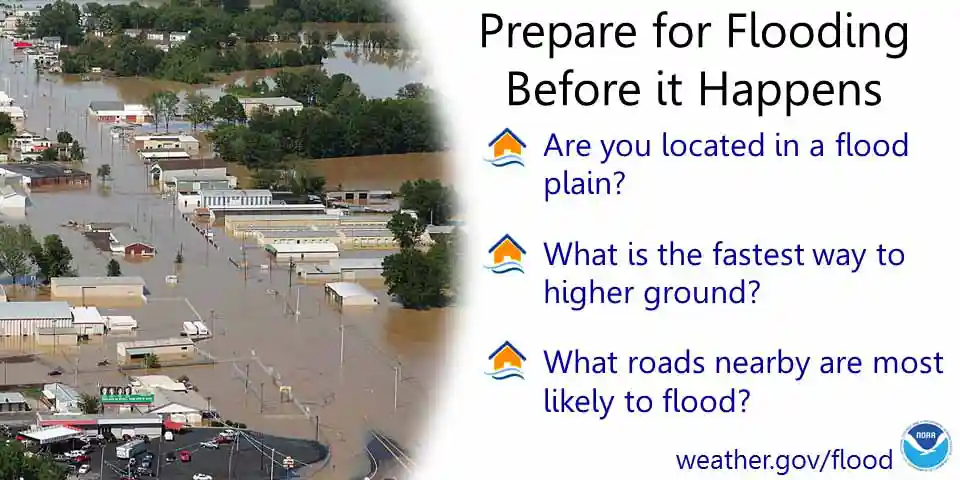
Most flood insurance policies have a 30-day waiting period, so it’s best to get your coverage in place before the flood risk is raised.
Different insurers offer different levels of coverage – the National Flood Insurance Program (NFIP) provides insurance of a maximum of $250,000 for the structure of your home and $100,000 for your contents. Other private providers offer policies which give more or less coverage than this, so shop around for the best option for your property.
The Federal Emergency Management Agency (FEMA) categorizes different parts of the country within “flood zones”:
- “A” zones are one of the most hazardous flood zones to live in. These properties are usually located near a body of water. If you live in an A Zone, you’re legally required to get flood insurance.
- “V” zones are also very hazardous. Properties in a V Zone are usually in first-row beachfront locations. As with A Zone properties, you’re legally obliged to get flood insurance if you live in a V Zone.
- “X” zones are the areas least threatened by flooding. You don’t have to get flood insurance if you live an X Zone, but it might still be worth considering.
- “D” zones are unknown. These areas haven’t been studied, but, as with any part of the United States, flooding is possible.
Although flood insurance is the only type of insurance that specifically protects you from flood damage, some types of insurance might give you limited coverage if your home is damaged by flooding, while others will not provide any coverage. Read the fine print of your existing insurance policies to find out more.
Stock Up On Sandbags
Sandbags are a great way to prevent damage from floodwaters. By stacking them in front of entrances to your home, you can divert water around your property rather than through it. You can buy sandbags from most hardware stores, and there are also some specialty sellers of anti-flooding equipment that carry sandbags as well. In an emergency, you can make your own sandbags by filling pillowcases or trash bags with sand. If sand isn’t available, soil from your backyard can also help in last-minute situations.
How To Seal Doors From Flooding
Doors are the main entry point for floodwaters. Sealing your external doors by caulking around the frame can dramatically reduce the amount of floodwater that gets in. You’ll need to seal your doors in good time, before the flooding starts, because caulk needs around 48 hours to completely dry and cure.
Although flood-resistant doors are available – these have built-in sealing at the bottom – it’s more common to buy attachable flood traps or seals. These are added to the bottom of the door to prevent water seeping through.
Understand Flood Warnings
There are two types of announcement you might hear before a flood: watches and warnings.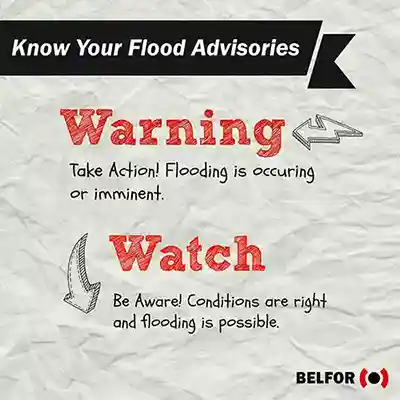
Flood watches are sent out when flooding is expected within the next two days.
Flood warnings mean that flooding is imminent or even occurring at the time.
Flash flood warnings are issued at short notice and mean that you need to take action straight away. Flash floods take anywhere from minutes to a couple of hours to develop.
Flood watches and warnings are both issued by the National Weather Service via radio, TV and their website.
What To Do During A Flood
It’s important to make sure you have access to regular updates when a flood hits. Keep your cell phone charged and your TV tuned to local news or weather. It’s also good to keep a radio on hand so you can still receive updates even if your power goes out and cell phone service is interrupted.
Move Your Possessions
When the rain begins, and flooding becomes likely, try to move any valuable possessions to higher ground. Take small valuables and heirlooms first, saving items of sentimental value. Also consider moving smaller appliances and other valuables upstairs if possible.
Once the flood hits, move to the upper floors of the building to avoid rising floodwaters. Remember to have your emergency kit with you.
Electrical and Gas Safety
In flooding scenarios, one of the biggest dangers to your safety is electricity. Water conducts electricity, meaning that if an electrical current from a wire or plug enters floodwater, you risk serious electric shock if you come into contact with it. To avoid this danger, disconnect all electrical goods and unplug appliances when a flood is imminent. Next, if it’s safe to do so, turn off electricity at the main circuit breaker or fuse box.
If you don’t have time to unplug all the appliances or shut off your electricity before flooding begins in or around your home, you need to be aware of the risks and take necessary precautions:
- Don’t go into a room in which water has reached the power outlets in your walls, or if water covers a plugged-in appliance.
- If you see any sparks or hear buzzing noises coming from a room, stay out of there.
- Keep away from ground level electrical boxes.
If flooding is expected in your area, shut off your gas too. Gas pipes are a vulnerable part of your property and may be damaged by floodwater, causing leaks. Prevent this by shutting off the utility and being alert to the smell of natural gas and propane.
Flood Evacuations
If an unexpected flash flood hits while you’re driving, or if you have no choice but to drive during an ongoing flood, there are several things you can do to stay safe:
You can also get evacuation updates from the radio station of the National Oceanic and Atmospheric Administration (NOAA) or your local alerting systems.
You should evacuate as soon as you’re instructed to do so. Follow the barricades set up by local responders. These are designed to safely guide traffic out of the area. Do not try to drive around barricades, even if the road looks safe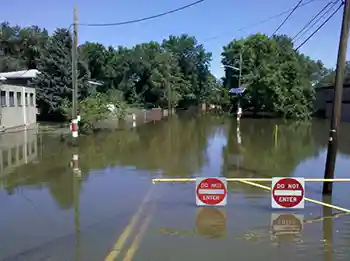
It’s useful to remember the “6 Ps” during a flood evacuation:
- People
- Pets
- Prescriptions
- Papers – electronic copies on external hard drives
- Personal needs – food, water, clothes, phones, chargers and cash
- Priceless items
Driving During A Flood
In cases of severe flooding, you may have to evacuate the area. The Emergency Alert System (EAS) issues evacuation instructions. You can get updates from the EAS via radio and television. Many cellular carriers and mobile apps also push out alerts in instances of severe weather.
- Avoid driving through floodwaters. Turn around instead. This applies to travelling on foot, too. Just six inches of moving water is enough to knock an adult over, and most vehicles can be moved by two feet of flooding.
- Don’t travel across bridges that are above fast-moving floodwaters. These waters can sweep away bridges. If you do get trapped in fast-moving water while in your car, don’t get out.
- Stay in the car. If the water gets inside the car and the vehicle begins to fill up, try and go onto the roof.
How To Clean Up After A Flood
Returning To Your Home
If you were forced to leave your home for safety reasons when the flood hit, don’t go back until you’re told it’s safe to do so. Listen out for broadcasts from the EAS, NOAA radio or local weather warnings to learn more.
Once it’s declared safe, carefully return to your home, but don’t drive unless you have to.

Check For Electrical Damage and Gas Safety
After a flood, anything that uses or supplies electricity in your home could be a health risk. If a lot of water got into your house and there’s any chance it came into contact with electricity, do not enter your home. Call your power company and have them shut off all your power. Even if your home did not take on a lot of water, you should still be cautious after the floodwaters have receded. Look out for:
- Standing water, and avoid contact with it
- Have a flashlight on hand
- Check your fuse box. If there’s water inside the fuse box, don’t touch it. Call a professional for help instead. If there’s no sign that the fuse box has been adversely affected by water, switch it off if it isn’t already switched off.
- If you didn’t get a chance to unplug your appliances before the flooding occurred, do so now.
Make sure you DO NOT:
- Touch exposed wiring
- Use candles to light the property – there could be unseen fire risks, such as gas leaks
- Use any appliances that are powered by the AC current power supply, until a professional confirms that it’s safe for you to do so
- Carry out repairs or clean the property until you know it’s safe
If you did not turn off your gas supply prior to flooding, be alert for any smells of natural gas. If you smell any, contact an engineer immediately. If it is safe to do, turn off your gas supply after a flood to prevent the risk of a leak. Natural gas can be toxic to humans and animals and also poses an explosion risk if it comes into contact with any small sparks or flames.
Contamination and Floodwater
All sorts of dangerous chemicals and toxins can get into floodwater, such as acid from car batteries, sewage waste and other organic matter. Because of this, bacterial and microbial contamination in your home is a real danger. You should throw away any household items that have been submerged in floodwater. Hire a professional cleaning team to disinfect your property after flood damage and salvage any possessions that were not fully submerged or heavily damaged.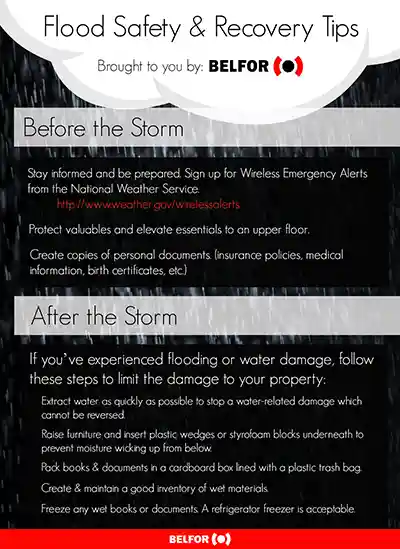
Your drinking water supply may also be contaminated by floodwater, so look out for any updates from your supplier. If you notice any discoloration to your water supply, avoid using it for drinking or bathing as it may contain harmful bacteria. Use bottled water instead.
Mold growth is another health threat caused by flooding. Andrew Miall, Professor of Geology at the University of Toronto, explains the threat posed by mold:
“Flooding can bring polluted waters, of course, which are a public health danger, but the main issue is likely to be mold from widespread dampness, even in places that are not actually put under water by the flood.”
Before you can deal with mold, you need to clear out any standing water, once you’ve ensured that your property is free of electrical and gas-related dangers. If there’s too much water for you to clear out, consider contacting a professional restoration service. You may need to engage a professional if water is in a subterranean space, because it won’t drain naturally. High volume of flooding may also require a professional, as otherwise there is the possibility that the floodwater will affect another area or property.
Take Pictures For Insurance
When you’re sure your home doesn’t pose any immediate risk to your safety, take pictures of your property to show the extent of the damage to insurance companies. This is particularly useful if you included “before” photos in your flood action plan.
Flooding can cause long-term damage to your home, but with proper preparation and measures taken after flooding strikes, you can mitigate the damage.

